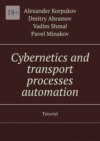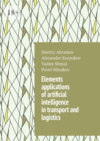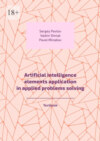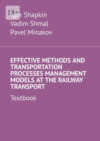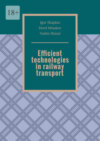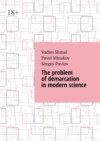Читать книгу: «Intelligent transport systems development», страница 2
2.2 Current issues of ITS development
Intelligent transport systems (ITS) are the result of the system integration of modern navigation, information and communication technologies, automation, transport infrastructure, user facilities, focused on ensuring the safety and efficiency of the transport process, logistics, and improving comfort for drivers and passengers.
Many countries already have experience in creating intelligent transport systems. Thus, since the early 1980s, the United States, European countries and the Asia-Pacific region have been implementing programs focused on information technology for high-speed highways. Currently, the global ITS market continues to develop dynamically.
The creation of a unified information infrastructure of the transport complex is especially important for the Russian Federation, located in nine time zones and actively using all types of transport.
Already today, GLONASS satellite navigation technologies are used in almost all areas of human activity. These are law enforcement, security and search systems, coordinate and time support, monitoring of complex engineering structures, dangerous goods and various types of transport, people and animals, geodesy and cartography, agriculture, construction, synchronization of telecommunications and energy networks, hydrometeorology, etc.
Developing the concept of ITS of Russia, it is necessary to take into account the possibilities and prospects of modernization of the domestic global navigation satellite system GLONASS. Satellite navigation is the technological basis of intelligent transport systems. This is a unique Russian satellite navigation system in terms of coverage and significance.
Due to the peculiarities of the ballistic construction of orbital groupings, the GLONASS system surpasses GPS in high latitudes in terms of availability and is somewhat inferior in the equatorial zone. Currently, a new generation Glonass-K satellite with additional navigation signals at the L3 frequency and code separation is undergoing flight tests as part of the GLONASS orbital constellation, which will improve the accuracy of navigation definitions by using more broadband signals in the frequency ranges allocated for the GLONASS system. At the same time, within the framework of international cooperation, code separation can ensure the compatibility and complementarity of existing and emerging global and regional satellite navigation systems.
To improve the quality of navigation services provided to consumers, a set of functional additions to the GLONASS system is designed, which is an element of the general system. It provides consumers with information about the integrity of the navigation field, updated ephemeris-time information, corrective information for navigation measurements, as well as information about the quality of the functioning of GLONASS and GPS.
Complexes of functional additions by the size of the territory of action can be classified into local (150 km), regional (1000 km), wide-band (up to 5000 km).
An example of a wide-band system of functional additions is the system of differential correction and monitoring of radio navigation fields (SDCM). The Russian SDCM is a functional addition to the GLONASS and GPS satellite navigation systems, which improves their characteristics for solving tasks requiring high accuracy and reliability.
The SDCM includes a measurement collection complex, including measurement collection stations on the territory of the Russian Federation and abroad, a SDCM center and a complex for delivering information to consumers.
The primary measurement information is sent to the SDCM center, where it is processed in order to clarify ephemeris-time information, determine the integrity parameters of the navigation-time field and form a message for the consumer.
SDCM messages will be delivered to consumers via satellite and terrestrial data transmission channels. The basis of the orbital grouping (OG) SDKM will be the spacecraft of the multifunctional space relay system «Luch» in geostationary orbit.
The SDCM orbital grouping will ensure guaranteed delivery of corrective information to consumers almost throughout the Earth, with the exception of the polar regions and the North American continent.
Simultaneously with the creation of space channels for the delivery of SDCM information, a website providing operational and a posteriori data for monitoring the state of GLONASS and GPS navigation and time fields was put into trial operation. The SDCM information transmission system is being tested over ground communication channels. This will allow you to work out, check and confirm the characteristics of the information generated by the SDCM, without waiting for the launch of the Luch spacecraft.
The commissioning of the SDCM significantly increases the accuracy of navigation definitions. So, if the accuracy of determining the coordinates by the consumer in units of meters is provided in offline mode, then when using information about the SDCM, the accuracy reaches a centimeter level.
In addition, the SDKM will allow solving the tasks of monitoring road transport, drivers’ compliance with traffic rules, boarding and disembarking passengers of a public transport port in designated places. With the help of SDCM, the tasks of monitoring the location of railway trains on adjacent tracks, optimizing the management of shunting locomotives in the areas of marshalling yards and railway junctions will also be solved at a new qualitative level.
For water transport, the SDCM will simplify the solution of the tasks of pilotage of ships, accurate and prompt installation of signs of the navigable situation. With the help of SDCM, the tasks of automating the landing of air transport will be solved. SDCM information will also be in demand for monitoring the processing of the roadway, accurate and operational linking of construction sites in absolute coordinate systems, monitoring and control of the condition of complex engineering structures.
The combine use of information systems and navigation technologies will make it possible to effectively solve the tasks of monitoring facilities and resources to improve the quality of life of the population, ensure high rates of economic growth and competitiveness of the national economy, create potential for future development, increase the level of defense capability and security of the state.
One of the most popular areas of satellite positioning is the monitoring of mobile objects, such as vehicles, people with physical and age disabilities, children.
Being important elements of ITS, vehicle monitoring systems can improve the quality of public transport services, the safety of passenger and cargo transportation, the efficiency of transport management, control fuel consumption, technical parameters of special equipment, cargo safety, etc. Practice shows that the use of such systems at the enterprise increases the efficiency of using vehicles by 10—40%.
According to statistics, more than 1 million people per year die as a result of road accidents in the world. In this regard, JSC «Russian Space Systems» submitted to the Commission for Modernization and Technological Development of the Economy under the President of the Russian Federation the project Emergency Response System in case of accidents «ERA-GLONASS», aimed at reducing the severity of the consequences of road accidents. A similar system is already being developed and implemented in the European Union. Thanks to the equipment of the vehicle with automated navigation terminals of domestic production, transmitting emergency response services information about the accident, including the coordinates of the vehicle, the time interval between the incident and the provision of assistance to victims is reduced.
Systems where the objects of monitoring are technical means should also include monitoring systems for small aircraft. Their use will make it possible to obtain a significant economic effect, but most importantly, it will contribute to saving human lives and radically reducing financial costs in the aftermath of plane crashes.
To determine the displacements of structural elements, high-precision monitoring of the displacements of engineering structures (HMDES) using GLONASS signals is used. The HMDES program allows you to determine offsets with millimeter accuracy. Based on the data obtained, an analysis is carried out and, if necessary, a decision is made on emergency measures to prevent an emergency situation or evacuation of the population. In addition, the system of high-precision monitoring of displacements of engineering structures can be used to monitor displacements of the Earth’s crust and tectonic processes.
There are many examples of using satellite navigation technologies to improve the efficiency of almost all modes of transport, each of which develops its own corporate information systems aimed at solving internal problems. Unfortunately, the lack of unification during their creation and implementation made these systems autonomous, excluding intersystem interaction and centralized management.
In our opinion, the most expedient way to solve the unification problem is to develop a system of standards that, on the one hand, would allow each application to have its own optimal solutions and communication channels, and on the other – unified network protocols. This would make it possible to serve various modes of transport and ensure efficient intermodal transportation within a single information infrastructure.
In addition, today there is a need to create a unified transport system of a new generation. Regional navigation and information systems (RNIS) based on GLONASS technologies should be used as its basis. For the first time the concept of RNIS was introduced by JSC «Russian Space Systems» in 2003 when creating a Regional navigation and Information System of the Yaroslavl region.
The priority areas of the ITS concept in Russia include:
■ consolidation of resources, technologies and qualified personnel in the field of navigation and transport telematics;
■ introduction of ITS in large cities, development of the federal road network and construction of toll roads with mandatory deployment of modern ITS components;
■ formation of international transport corridors harmonized with European ITS standards.
Integration into international intelligent transport systems will allow creating a unified, highly needed harmonized global ITS for consumers, which will increase the competitiveness and economic efficiency of the Russian transport sector, the safety of freight and passenger transportation.
2.3 Development of intelligent train operation management technologies
The national transport policy of many developed countries is currently based on the development and promotion of intelligent transport systems (ITS). They are considered as an effective means of solving urgent problems of the transport industry, such as an unacceptable level of human losses as a result of transport accidents, delays in the turnover of passengers and cargo, insufficiently high productivity of the transport system, increased energy consumption, negative impact on the environment, etc. In addition, ITS is an incentive for the development of a number of industries and new innovative technologies. The latter include technologies for the creation of intelligent control and monitoring systems, the creation of new transport systems and their management, the production of nanomaterials, the creation of energy-saving systems for transportation, distribution and consumption of heat and electricity in the field of railway transport, processing, storage, transmission and protection of information, software production, risk reduction and reduction of the consequences of natural and man-made disasters, etc.
A nationwide ITS program is being developed in Russia, which can become an effective tool for implementing the Transport Strategy of the Russian Federation for the period up to 2030. In particular, the Federal Law «Intelligent Transport System of the Russian Federation» is currently being discussed. In the draft of this law, the intelligent transport system is defined as an integral part of the infrastructure of the transport complex, implementing the functions of automated management, information, accounting and control to ensure the legal, financial, technological and information needs of participants in the transport process, as well as meeting the requirements of transport, information and economic security of society. As follows from this definition, it is assumed that the system integration of modern information and communication technologies and automation tools into the transport infrastructure, vehicles in order to improve the safety and efficiency of transport processes. In relation to railway transport, the development of ITS is defined by such a directive document as the Strategy for the Development of Railway Transport in the Russian Federation for the period up to 2030.
2.4 Goals and objectives of ITS creating in railway transport
The goals of creating intelligent railway transport systems are to reduce the transport losses of the population and transport costs in the sphere of economy, business and services, to intensify economic and social processes, to improve traffic safety, to improve the environmental situation, to reduce the negative impact of the human factor on the quality of management, to increase the attractiveness of railway transport for passengers and cargo owners. Achieving these goals involves solving a large number of tasks. These, in particular, include:
■ improving the efficiency of using the existing railway network by more evenly distributing railway rolling stock in time and space;
■ improvement of technological, informational and social components of traffic safety;
■ providing managers at all levels with the necessary information to make operational and strategic decisions based on modeling and assessing the impact on the transport system of new and modernized transport facilities;
■ formation of a rapid response scheme of transport services, which allows to quickly take measures in case of emergencies, adverse weather conditions, etc.;
■ creation of monitoring systems for transport infrastructure and traffic conditions, allowing to assess the state of the transport system in real time and predict its changes.
3 MODERN SCIENTIFIC AND METHODOLOGICAL APPROACHES TO THE ITS CREATION IN RAILWAY TRANSPORT
To date, there is no unified understanding of what intelligent transport systems are. In many publications and speeches, they are more or less identified with conventional automated transport systems. An important feature of ITS, which makes it possible to distinguish such systems into a separate class and even into a separate area of research in railway science, is the formal logical and mathematical tools used to solve problems from the standpoint of a system-wide approach to the analysis and management of all systems and processes in railway transport.
It should be emphasized that modern railway transport belongs to the category of extremely complex technical and organizational systems, the management of which is currently practically impossible within the framework of previously established traditional approaches. The complexity of the transport infrastructure and its facilities (railway junctions, stations, transport corridors, etc.) fundamentally excludes the possibility of working in a fully automatic mode. In other words, it is impossible to effectively manage such a system only with the involvement of classical methods for solving complex mathematical modeling problems, search and development of new approaches are required. At the same time, great hopes are placed on intelligent systems that, along with accurate mathematical models, use data and knowledge accumulated in the course of their activities. The work of such systems can, and sometimes should, be based on the formalized experience of highly qualified specialists. Proceeding from this, JSC «Russian Railways» now needs to develop the fundamental foundations for the creation of intelligent railway systems using complex interdisciplinary approaches that can find practical application in a short time.
Special attention should be paid to the fact that railway transport management systems, as well as complex systems in general, are characterized by fundamental inaccuracy and uncertainty in both data and management decisions. This makes it possible to attribute such systems from a mathematical point of view to the class of incorrect tasks and makes it possible to evaluate the quality of technical and managerial decisions in a different way. In this case, the promptness of the decisions taken plays a greater role than their optimality, understood in a strict mathematical sense. This quality is an important property of intelligent systems [14,15,16].
In recent decades, there has been an active development and research of formal methods of working with uncertain data. Until recently, probability theory was the main instrument for accounting for uncertainty. However, the axiomatic limitations associated with it do not allow us to adequately apply probabilistic approaches to solving many important problems in which uncertainty has a different nature or properties. For example, the uncertainty of the events under consideration does not always have a frequency character, objective difficulties often arise with the formalization of a specific probability space, in many cases assumptions about the additive nature of a probability measure are difficult to explain, and sometimes simply unacceptable. For these reasons, at present, along with probability theory with its developed mathematical apparatus, new theoretical approaches to the description of uncertainty and incompleteness of information are actively being investigated. Here, first of all, we should mention the Dempster – Shafer theories, possibilities, interval averages, monotone measures. These theories have less rigid axiomatics, which allows, along with the frequency interpretation of events, to describe events whose uncertainty may be subjective (for example, the probability is determined by a number reflecting the subjective degree of confidence in the event), or in which the number of observed realizations does not allow obtaining reliable conclusions in a statistical sense.
An important area that can have real practical application in the railway industry when creating ITS is the development of expert systems, i.e. computer programs that can fully or partially replace a specialist expert in some, as a rule, rather narrow problem area. Expert systems began to be developed by artificial intelligence researchers in the 1970s, and already in the 1980s they found their commercial applications. Expert systems function mainly together with knowledge bases, which are a set of facts and rules of logical inference in the chosen subject area of activity. This allows, in general, to model the behavior of experienced specialists in a certain field of knowledge using logical inference and decision-making procedures.
A person, unlike a computer, has fuzzy thinking, effectively operates with variables not only quantitative, but also qualitative. Therefore, expert systems that model the style of human reasoning are especially successfully used in solving complex problems associated with the use of hard-to-formalize knowledge. It is important to understand that the creation of a specific expert system is a long and expensive process that requires the involvement of specialists in various fields – programmers, knowledge engineers, experts in the field of application under consideration. One of the main problems in this case is the formation of knowledge, which is transmitted during numerous interviews of a knowledge engineer and an expert in the subject area. The stage of knowledge acquisition is one of the main bottlenecks in the technology of creating expert systems due to the low rate of filling the system’s knowledge base. It should be added to this that there are subject areas for which it is often difficult to find an experienced expert person, and sometimes there simply does not exist one. In addition, it has long been noticed that not all experts are ready and able to share their knowledge [2,8.10].
An important quality of technical systems that allows them to be classified as intelligent is the presence of such properties as:
■ learnability – the ability to generate new knowledge and data (models, decision rules) based on inductive inference mechanisms, generalization of statistical data, etc.;
■ classification ability – the ability of the system to independently differentiate control objects, environmental influences, control signals, automatically structure data;
■ adaptation – the ability of the system to adapt to the changing conditions of the operating environment, correctly take into account the non-stationarity of control data, etc
One of the promising approaches to the creation of intelligent systems may be to attract the ideas of situational management as a system – wide approach based on formal methods of theoretical artificial intelligence – logical-linguistic models, models of learning technical systems in the construction of management procedures for current situations, deductive systems for building multistep solutions, etc. In this important area of research, as well as in the development of general methodology, theoretical foundations and specific applications, priority undoubtedly belongs to Russian scientists.
The problem of industrial implementation of intelligent information systems capable of processing data with their inherent a priori uncertainty in railway transport is becoming more and more urgent. In many cases, the data is not only inaccurate and uncertain, but also incomplete, and sometimes unreliable. The development of methods that allow obtaining reliable conclusions based on such data is another direction for fundamental research.
Бесплатный фрагмент закончился.














